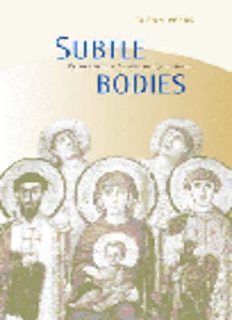
Subtle Bodies: Representing Angels in Byzantium (The Transformation of the Classical Heritage) PDF
Preview Subtle Bodies: Representing Angels in Byzantium (The Transformation of the Classical Heritage)
Subtle Bodies the transformation of the classical heritage Peter Brown,General Editor i Art and Ceremony in Late Antiquity,by Sabine G. MacCormack ii Synesius of Cyrene: Philosopher-Bishop,by Jay Alan Bregman iii Theodosian Empresses: Women and Imperial Dominion in Late Antiquity,by Kenneth G. Holum iv John Chrysostom and the Jews: Rhetoric and Reality in the Late Fourth Century,by Robert L. Wilken v Biography in Late Antiquity: The Quest for the Holy Man, by Patricia Cox vi Pachomius: The Making of a Community in Fourth-Century Egypt, by Philip Rousseau vii Change in Byzantine Culture in the Eleventh and Twelfth Centuries, by A.P. Kazhdan and Ann Wharton Epstein viii Leadership and Community in Late Antique Gaul, by Raymond Van Dam ix Homer the Theologian: Neoplatonist Allegorical Reading and the Growth of the Epic Tradition,by Robert Lamberton x Procopius and the Sixth Century,by Averil Cameron xi Guardians of Language: The Grammarian and Society in Late Antiquity, by Robert A. Kaster xii Civic Coins and Civic Politics in the Roman East, a.d.180–275, by Kenneth Harl xiii Holy Women of the Syrian Orient,introduced and translated by Sebastian P. Brock and Susan Ashbrook Harvey xiv Gregory the Great: Perfection in Imperfection,by Carole Straw xv “Apex Omnium”: Religion in the “Res gestae” of Ammianus, by R.L. Rike xvi Dioscorus of Aphrodito: His Work and His World, by Leslie S.B. MacCoull xvii On Roman Time: The Codex-Calendar of 354 and the Rhythms of Urban Life in Late Antiquity,by Michele Renee Salzman xviii Asceticism and Society in Crisis: John of Ephesus and The Lives of the Eastern Saints, by Susan Ashbrook Harvey xix Barbarians and Politics at the Court of Arcadius,by Alan Cameron and Jacqueline Long, with a contribution by Lee Sherry xx Basil of Caesarea,by Philip Rousseau xxi In Praise of Later Roman Emperors: The “Panegyrici Latini,” introduction, translation, and historical commentary by C.E. V. Nixon and Barbara Saylor Rodgers xxii Ambrose of Milan: Church and Court in a Christian Capital,by Neil B. McLynn xxiii Public Disputation, Power, and Social Order in Late Antiquity,by Richard Lim xxiv The Making of a Heretic: Gender, Authority, and the Priscillianist Controversy,by Virginia Burrus xxv Symeon the Holy Fool: Leontius’s Life and the Late Antique City,by Derek Krueger xxvi The Shadows of Poetry: Vergil in the Mind of Augustine,by Sabine MacCormack xxvii Paulinus of Nola: Life, Letters, and Poems,by Dennis E. Trout xxviii The Barbarian Plain: Saint Sergius between Rome and Iran,by Elizabeth Key Fowden xxix The Private Orations of Themistius,translated, annotated, and introduced by Robert J. Penella xxx The Memory of the Eyes: Pilgrims to Living Saints in Christian Late Antiquity, by Georgia Frank xxxi Greek Biography and Panegyric in Late Antiquity,edited by Tomas Hägg and Philip Rousseau xxxii SubtleBodies: Representing Angels in Byzantium,by Glenn Peers GLENN PEERS Subtle Bodies Representing Angels in Byzantium university of california press berkeley los angeles london University of California Press Berkeley and Los Angeles, California University of California Press, Ltd. London, England © 2001 by the Regents of the University of California Library of Congress Cataloging-in-Publication Data Peers, Glenn. Subtle bodies : representing angels in Byzantium / Glenn Peers. p. cm.—(The transformation of the classical heritage ; 32) Includes bibliographical references and index. ISBN 0-520-22405-1 (hardcover : alk. paper) 1. Iconoclasm—Byzantine Empire—History. 2. Angels—Biblical teaching. 3. Angels in art. 4. Angels in literature. 5. Byzantine empire— Church history. 6. Orthodox Eastern Church— Byzantine Empire—History. 7. Church history— Middle Ages, 600–1500. I. Title. II. Series. BR238 .P39 2001 235′.3′088219—dc21 00-055165 Manufactured in the United States of America 9 8 7 6 5 4 3 2 1 0 10 9 8 7 6 5 4 3 2 1 The paper used in this publication meets the minimum requirements of ANSI/NISO Z39 0.48–1992(R 1997) (Permanence of Paper) . contents list of illustrations ix acknowledgments xi abbreviations xiii introduction 1 one issues in representing angels 13 two arguments against images of angels 61 three representing angels: images and theory 89 four the veneration of angels and their images 126 five apprehending the archangel michael 157 conclusion 194 bibliography 209 index 231 illustrations 1. Icon of the Archangel Michael(?). 18 2. The Israelites at the Twelve Springs. 22 3. Sarigüzel sarcophagus. 25 4. Barberini Diptych. 27 5. Mosaic of the Seasons, detail of Personification of Spring, from Daphne near Antioch. 29 6. The Tomb of Christ, upper register—Soldiers Asleep at the Tomb; lower register—Marys and Angel at Tomb. 34 7. Philoxenia of Abraham, mosaic, S. Vitale, Ravenna. 39 8. Two winged men inscribed “EXOUÇIE” (“Powers”). 42 9. Angelic Powers, south side, Bema Mosaic (destroyed), Church of the Dormition, Iznik (formerly Nicaea). 44 10. Angelic Powers, north side, Bema Mosaic (destroyed), Church of the Dormition, Iznik (formerly Nicaea). 45 11. Icon of the Virgin and Child, flanked by Saints Theodore and George. 51 12. Archangel Gabriel, Mosaic, Bema arch, Hagia Sophia, Istanbul. 54 13. Virgin and Child, Apse Mosaic, Hagia Sophia, Istanbul. 55 14. Vision of Isaiah, The Christian Topography. 56 illustrations ix
Description: